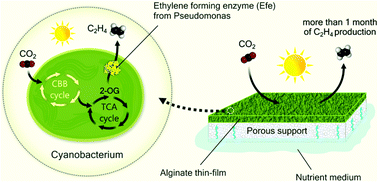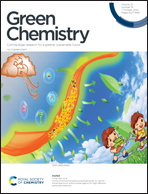Towards sustainable ethylene production with cyanobacterial artificial biofilms†
Abstract
Photosynthetic cyanobacteria hold a great potential for the direct conversion of solar energy and CO2 into ‘green’ ethylene. The present study aims to develop a thin-layer artificial biofilm technology for sustainable and long-term ethylene photoproduction, where recombinant Synechocystis sp. PCC 6803 cells holding ethylene forming enzyme (Efe) from Pseudomonas syringae are entrapped within the natural polymer matrix, thus forming the thin-layer biocatalytic structure. The production system was optimized by varying different parameters, such as radiance, inorganic carbon level, and periodicity of medium renewal. As a result, artificial films with entrapped cells of Synechocystis sp. PCC 6803 mutant produced ethylene for up to 38 days, yielding 822 mL m−2 ethylene at 1.54% light to ethylene conversion efficiency. These figures represent a 2-time enhancement in the duration of ethylene production, a 2.2-fold increase in the production yield, and a 3.5-fold improvement in the light to ethylene conversion efficiency as compared to the cell suspension. This study demonstrates that ethylene producing cyanobacteria entrapped in the polymeric matrix could truly act as photo-biocatalyst for the prolonged ethylene production by strongly limiting biomass accumulation and maintaining photosynthetic activity and cell fitness.



 Please wait while we load your content...
Please wait while we load your content...